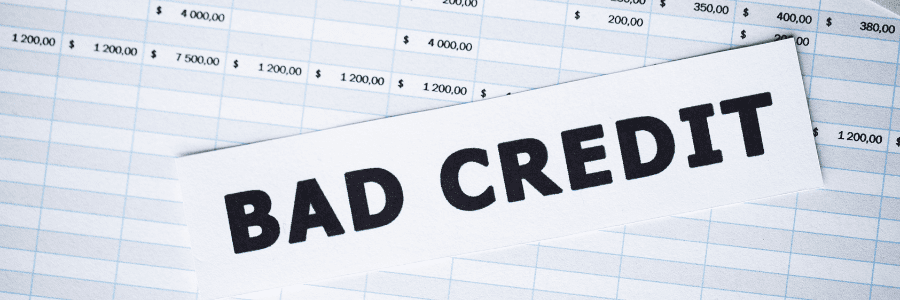Can You Refinance A Debt With Bad Credit?

Table of Contents
The Realities of Refinancing
Refinancing with bad credit means replacing your existing loan with a new one, even if your credit score is less than ideal. This process is typically done to secure a lower interest rate, drop mortgage insurance, or access the equity in your home.
In Australia, refinancing can have both short-term and long-term impacts on your credit score, such as:
- Closing a Loan. When you refinance, you close your existing loan and open a new one. This move can cause your credit rating to fall temporarily, especially if your current loan is a longstanding account with excellent repayment history.
- Credit Checks. Each time you apply for a refinance loan, it is processed as a new loan enquiry. This process registers as a “hard enquiry” on your credit report. Multiple hard enquiries over a short period can hurt your credit score.
- Skipping Mortgage Payments. Late or missed repayments can have a significant negative impact on your credit score.
It is crucial to calculate your monthly payments and ensure that refinancing is the right decision for you. If done correctly, the drop in your credit score from refinancing is temporary and should recover over time. However, the exact duration of this impact is complex and depends on various factors.
The Challenge of Refinancing with Bad Credit
Refinancing can be challenging if you have bad credit because it can limit your options for refinancing, as many lenders will see you as a high-risk borrower and may charge you higher interest rates or fees or reject your application altogether. However, this does not mean that refinancing is impossible if you have bad credit. You can improve your chances of getting approved for a new loan and saving money in the long run.
Here are some examples of scenarios where refinancing with bad credit might be possible and beneficial:
- You have equity in your property. Equity is the difference between the value of your property and the amount you owe on your loan. If you have at least 20% equity in your property, you can refinance to a non-conforming loan with a specialist lender who caters to borrowers with bad credit. A non-conforming loan is a loan that does not meet the standard criteria of mainstream lenders, such as banks and credit unions. Non-conforming loans may have higher interest rates and fees than conventional loans. Still, they can also offer more flexibility and features, such as an offset account or a redraw facility. An offset account is a savings account linked to your loan and reduces the amount of interest you pay by offsetting the balance of your loan. A redraw facility allows you to withdraw any extra repayments you have made above the minimum required amount.
- You have savings or assets. If you have enough savings or assets to reduce your loan-to-value ratio (LVR) below 80%, you may qualify for a non-conforming loan with a specialist lender. LVR is the percentage of the property value that you are borrowing. For example, if your property is worth $500,000 and you owe $400,000 on your loan, your LVR is 80%. The lower your LVR, the less risk you pose to the lender and the more likely you will get approved for refinancing. A lower LVR can also help you avoid paying lenders mortgage insurance (LMI), an insurance fee that protects the lender if you default on your loan. LMI is usually charged if your LVR is above 80%.
- You want to consolidate your debts. If you have multiple debts, such as credit cards or personal loans, that charge you high interest rates and fees, you can refinance your home loan to consolidate them into one payment. This decision can help you save money on interest and fees, simplify your budgeting and improve your cash flow. However, before refinancing to consolidate your debts, consider the pros and cons carefully. For instance, refinancing to consolidate your debts may extend the term of your loan and increase the total amount of interest you pay over time. You should also avoid taking on new debts after refinancing, as this could further worsen your financial situation and damage your credit score.
Where To Go To Refinance A Debt When Burdened With Bad Credit
If you are looking to refinance with bad credit, your best option will always be specialist lenders willing to give you a loan that leverages your equity instead of your credit score. This move would increase your chances of securing a loan compared to traditional banks.
When you have a poor credit rating, you’ll need to apply for what’s known as a non-conforming loan with specialist lenders willing to give you a loan that leverages your equity instead of your credit score. Your eligibility to refinance to a non-conforming loan is partly determined by your property’s current loan-to-value ratio as lenders look at your existing equity. The more equity you have in your property, the less of a risk the lender will see you. Most lenders will require that you have a minimum of 20% equity in your property. This condition means your LVR is under 80%, the benchmark where lenders perceive you as less risky. At least 20% equity will increase your chances of refinancing to a non-conforming lender.
Several lenders specialise in bad credit lending that could offer you non-conforming loans. However, talking to these financing companies separately can be a time-consuming affair. A more efficient way is to locate an experienced mortgage broker like Tiger Finance, who maintains a vast network of partner lenders who can offer you a wide array of financing options.
Tips On How To Refinance With Bad Credit
If you choose one of the options above or another option for refinancing with bad credit, here are some tips on how to prepare for the process and increase your chances of success:
- Get a copy of your credit report. Your credit report contains information about your credit history, such as the number and type of credit accounts you have, the amount of credit you have used, and any adverse events that have affected your credit score. You can get a free copy of your credit report once a year from one of Australia’s three leading credit reporting agencies: Equifax, Experian or Illion. You should check your credit report for any errors or inaccuracies that could lower your credit score and dispute them with the relevant credit provider or agency.
- Improve your credit score. Your credit score is a numerical representation of your creditworthiness based on the information in your credit report. It ranges from 0 to 1,200 in Australia, with higher scores indicating better credit quality. Your credit score can affect your eligibility for refinancing, and the interest rate and fees lenders offer you. Therefore, improving your credit score before applying for refinancing is essential. Some ways to improve your credit score include paying your bills on time, paying off any outstanding debts, keeping your credit utilisation ratio low (the percentage of available credit you use), and limiting the number of credit applications you make.
- Compare different lenders and loans. Not all lenders have the same criteria for refinancing with bad credit. Some lenders may be more willing to lend to borrowers with bad credit than others, depending on their risk appetite and lending policies. Therefore, comparing different lenders and loans before applying for refinancing is advisable. You can use online tools, such as comparison websites, calculators and guides, to compare the interest rates, fees, features and requirements of various refinancing options. You can also consult a mortgage broker to help you find the best deal for your situation and assist you with the application process.
- Provide evidence of your income and expenses. When you apply for refinancing, you must provide proof of your income and costs to the lender. This proof can include payslips, bank statements, tax returns, bills and other documents that show your financial situation. Evidence of your income and expenses can help the lender assess your ability to repay the new loan and verify your identity. You should also prepare a budget that shows how much you can afford to pay each month for your new loan and how refinancing will benefit you financially.
At Tiger Finance, we always guide you every step of the way with loan experts well-versed in the current situation in the world of financing. You can get a free consultation with our in-house financing expert without obligation to give you the most accurate picture of your loan situation today.
Contact Tiger Finance today so that we can help you begin your journey to secure the exact hassle-free loan product that you need.
Table of Contents
Find MOre Information

The ABCs of Business Marketing and Caveat Loans
The ABCs of Business Marketing and Caveat Loans Table of Contents Marketing is the process of promoting products or services to other businesses or organisations

Business Owners and Caveat Loans: Why They Fit
Business Owners and Caveat Loans: Why They Fit Table of Contents A business owner owns and operates a commercial enterprise independently or with partners. Business

Optimising Business Finances: Understanding Working Capital and Caveat Loans
Optimising Business Finances: Understanding Working Capital and Caveat Loans Table of Contents Working capital is a crucial indicator of a business’s financial health and operational

Exploring the Advantages and Disadvantages of Caveat Loans
Exploring the Advantages and Disadvantages of Caveat Loans Table of Contents Like many financial options, Caveat loans come with their advantages and disadvantages. Let’s begin

Unlocking Opportunities 3: How Business Owners Can Harness the Power of Caveat Loans
Unlocking Opportunities 3: How Business Owners Can Harness the Power of Caveat Loans Table of Contents Caveat loans, a form of short-term financing, offer business

Unlocking Opportunities 2: How Property Investors Can Harness the Power of Caveat Loans
Unlocking Opportunities 2: How Property Investors Can Harness the Power of Caveat Loans Table of Contents In the fast-paced world of real estate investing, the


